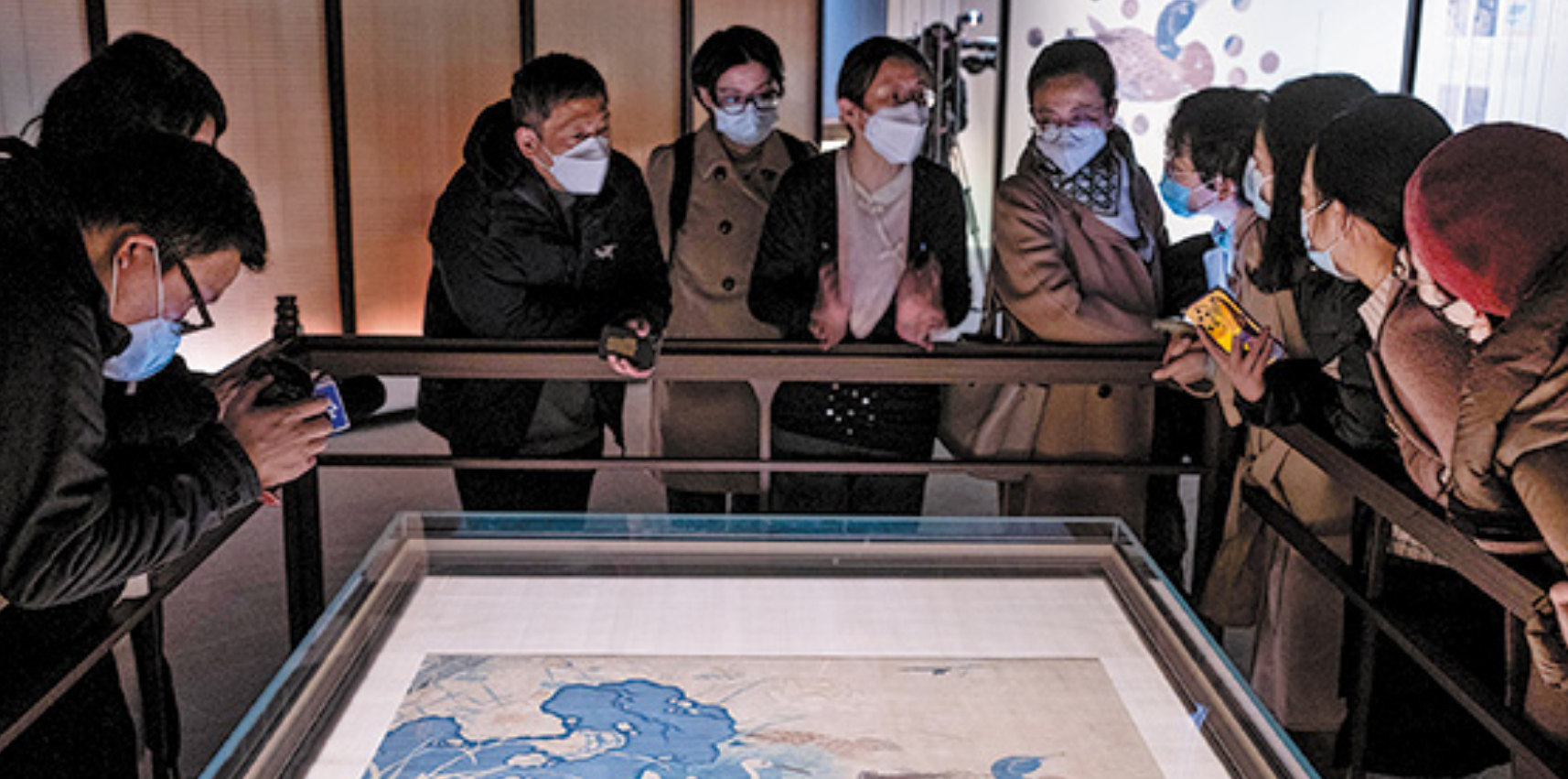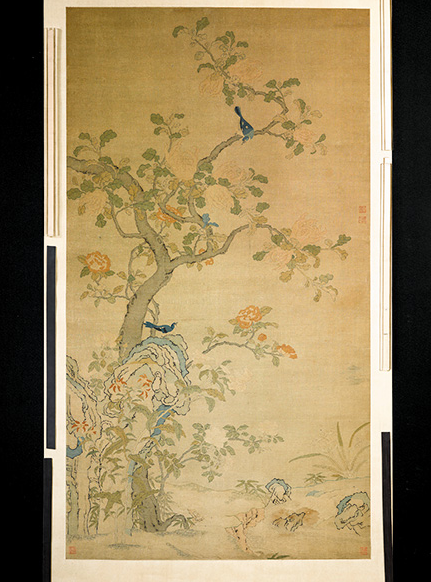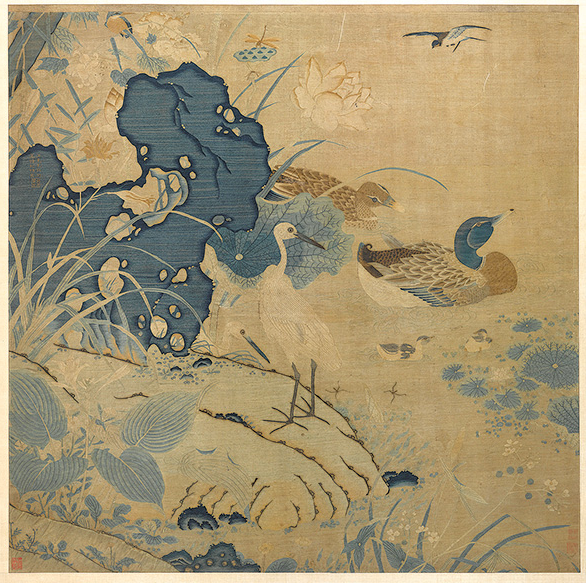政府新闻
难得一见的景象 2022-12-25

A researcher with the Shanghai Museum introduces a kesi (Chinese silk tapestry weaving) artwork to visitors.
The Shanghai Museum is now holding an exhibition featuring Ducklings on a Lotus Pond, an incredibly rare silk tapestry that dates back as far as the 12th century.
Visitors will be able to view the artwork, which is the only large-scale kesi piece by Zhu Kerou, a legendary craftswoman in the Southern Song Dynasty (1127-1279), at the No 3 exhibition hall in the Shanghai Museum from Dec 17 to Jan 1, 2023.
The fragile silk artwork was donated to the Shanghai Museum in 1952 by the family of collector Pang Yuanji (1864-1949) and was on show for just a short while before it was put in storage for preservation. It was last featured in an exhibition in Japan in 1993.
As this year marks the 70th anniversary of the founding of the Shanghai Museum, the institution decided to showcase this treasured piece to commemorate the occasion.
"Ducklings on a Lotus Pond is the epitome of flower-and-bird kesi tapestry of the Song Dynasty (960-1279)," says Chu Xiaobo, director of the Shanghai Museum. "Viewers will find that any change to their perspective will result in the gloss flowing on the silk surface in a different direction, and in a variation of light and shading of the mountain rock, ...ducklings and flowers depicted."
Such "dynamic ethereality", he adds, goes beyond the reach of the painting, and even surpasses the aesthetics of conventional calligraphy.

A silk artwork in the Ming Dynasty (1368-1644) depicts birds resting on a tree, which is in full blossom.
The artwork, which is 107.5 centimeters in length and 108.8 cm in width, depicts birds, plants, insects and rocks in a pond at the beginning of summer. According to Yu Ying, a researcher at the Shanghai Museum, the work is a unique, historic piece as such exquisite craftsmanship was "never before and never again achieved".
The Chinese handicraft of kesi, or silk tapestry, dates back to the Tang Dynasty (618-907), when wool tapestry was introduced to China from Western Asia through the Silk Road.
Traditionally woven by hand on a loom, tapestry is weft-faced weaving, in which all the warp threads are hidden in the complete work. The artisan would interlace each colored weft back and forth to create patterns and designs.
In China, craftsmen used raw silk as warp and boiled-off silk of various colors as weft, and this allowed for more details and visual expressions than wool. More than 80 threads can be found in each square centimeter of a kesi piece.
There is an adage that goes "an inch of kesi is worth an inch of gold "because of the intensive labor and craftsmanship involved. In this particular piece, some parts feature as many as 140 threads in 1 sq cm.
According to the inheritors of kesi, which is an intangible cultural heritage of China, adding a few more threads in a limited space meant addressing the challenge of "geometrical progression".
Zhu Gang, who goes by the courtesy name Kerou, was the most legendary kesi craftswoman in the Southern Song Dynasty. Based on the inscriptions and couplets in two artworks, Yu found that Zhu was a woman from Songjiang in today's Shanghai, and active during the reign of Emperor Gaozong (reigned 1127-62).

Ducklings on a Lotus Pond is a silk tapestry piece by Zhu Kerou, a legendary craftswoman in the Southern Song Dynasty (1127-1279).
It was Emperor Huizong (reigned 1100-26), an important artist himself, who encouraged and promoted the development of kesi. Under his influence, kesi advanced rapidly from a textile handicraft to a work of artistic excellence. It was also in this context that people like Zhu were able to develop their talent.
Zhu incorporated the art of imperial court painting into her craft by taking delicate threads of blended colors as palettes and employing the method of "long-and-short-thread inlay" as ink-wash brushes, thus creating an exquisite effect of color blending.
A fine piece like Ducklings on a Lotus Pond would require at least eight years to make and involve many other artisans handling the logistics, such as the rearing of silkworms, the making of silk, and the dyeing of threads, Yu says.
However, judging from the upper part of the piece, where a single swallow and dragonfly look to be inconsistent with all the other animals that appear in pairs — a symbol of auspiciousness — Yu believes the composition was incomplete.
Also, the artwork was never part of the imperial collection, but kept as a hidden treasure in civilian society.
In the early 20th century, the artwork was owned by Pang, an entrepreneur and important connoisseur and collector of Chinese art from Nanxun, an ancient town in Zhejiang province.
In 1952, Pang Weijin and other descendants of Pang Yuanji donated it and five other pieces of kesi and calligraphy artworks from the Ming (1368-1644) and Qing (1644-1911) dynasties to the Shanghai Museum. A handwritten note attached to these works reads: "Such priceless treasures in the world ought not to belong to private collectors like us. Rather, they should be donated to our nation and admired by our people, immediately."
To protect the fragile artwork, the Shanghai Museum strictly controls the lighting, temperature and humidity in the exhibition hall, and has capped the number of visitors at 50 every 20 minutes. Visitors have to make an appointment for the exhibition through the museum's WeChat platform.
If you go
Ducklings on a Lotus Pond: A Kesi Tapestry Enshrined in the Shanghai Museum
Dec 17-Jan 1, 2023.
No 3 Exhibition Hall, Shanghai Museum, 201 Renmin Avenue, Huangpu district, Shanghai.
021-6372-3500.
Source: China Daily
